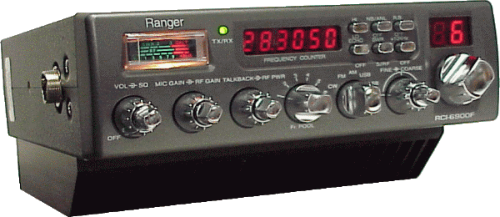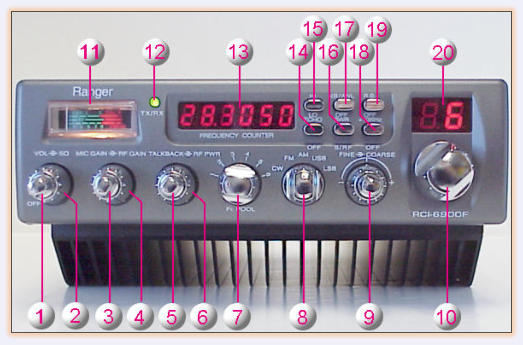





Review of the RCI 6900F TB 10 Meter Transceiver
by Bob F
The RCI 6900F TB is a fine looking
transceiver. There are two versions
of the RCI-6900. First is the RCI-
6900F HP. The HP stands for high
power. This may be confusing to
many operators, but the HP
apparently first came along with the
Connex 3300HP. High power back then
meant a dual final radio. The early export
radios had single final output stages and
Connex used the HP to show the distinction
between those radios and their higher power version. The other is
the
RCI-6900F TB, which is reviewed in this article. The TB stands for turbo. This designation
was first used on the Galaxy Saturn Turbo base station, which was a 100-Watt radio. Instead of having two
different part numbers as they do with the 2950 and 2970, they chose this method of distinction.
This radio incorporates a main circuit of a newer design. It shares the front-end, mixer and IF stages with
the RCI 2950DX. Oh, yes it even shares the problem related to the sideband crystal filter area of the board.
This radio incorporates SMT, surface mount technology type circuit board. As I've discussed in earlier
issues, this technology is the wave of the future in electronics. This type of construction is far more reliable
but more difficult to repair or rework. The advantages are many in using this type of circuit board. The
components are much smaller which means more components will fit in a smaller area. This advantage can
be used to reduce the size of a product, increase the complexity of the circuitry in a given area, make the
unit less congested, or all of the above. In addition, although the components are still a little more
expensive, manufacturing is automated reducing assembly cost.
Initially I shied from this radio because earlier versions of this 12 band PLL design weren't good in the
sideband mode of operation. Strong received signals were garbled and the transmission had a slight
warble to it. In addition, there were reports from another radio dealer that in sideband mode RCI-6900F TB
would indicate a high level output with no audio applied. Looking at the internal RF meter, it looked as if
there was a carrier on sideband. This happened only on certain antennas.
Earlier this year a customer sent an earlier version of the RCI-6900F TB for repair of the carrier problem
mentioned earlier. After analysis, I determined the 150-amplifier stage was going into oscillation. This
occurred because there was no negative feedback on the output amplifier. This was immediately solved by
adding a 51W 1-watt resistor in series with a .01 mf capacitor from the base to the collector of the 2SC2290
transistors. The current RCI-6900F TB radios have this negative feedback installed. They use a 47W
resistor in series with a .01 mf capacitor. See Photo for location of components.

Initial bench testing indicated Ranger also cured the PLL stability problem; this radio was solid as a rock drifting only 40 Hz
from turn on to one hour of use. However, as mentioned earlier, the receiver has the same imaging problem on sideband as the
RCI-2950DX tested in our September issue. Testing the receiver on AM and FM concluded this radio performs better in those
modes than many other 10-meter radios of the past and present. Testing the sideband receiver indicated very high sensitivity,
but low selectivity. Injecting a signal that read 30dB on the “S” meter, resulted in a clear reception of this signal 10KHz on either
side of the channel with a reading of “S” 9 on the radio's meter. This signal stayed the same approximately 100KHz on either
side of the channel and slowly decreased to a “S” 7 over 200KHz or 20 channels on either side of the channel. It’s important to
note that the signal isn’t distorted like ordinary splash or bleed-over, it remains clear, as if it were on the same frequency
blending in with other transmissions. This may be why I’m hearing that nobody has complained, the end user may think the
signal is on the same channel, because it blends with the other sideband traffic. Removing the filter from the circuit board
revealed the same “S” 9 signal on the test channel as on the adjacent channels as well as displaying the same results as if the
filter were still in place. The good news is that the same fix works, as I expected, for the RCI-6900F TB as the RCI-2950DX.
See the article RCI 2950DX Image Rejection Modification for the information needed to perform this modification. Please
remember, you’re on your own. If you’re not sure if you have the soldering equipment or skills to perform repairs or rework of
SMT, don’t attempt it. Damaging the radio will surely void your warranty! CB World Informer can’t and will not be responsible for
any actions individuals take using our information.
Testing the transmitter on the bench indicated an issue with the sideband ALC. At full power the first second or so of
transmission only reached 10-Watts PEP, regardless of mic input or mic gain. It would then reach momentary peaks of 100-
Watts with an average of 35-Watts PEP. After every loud syllable the ALC was so tight the next two or three words were
reduced to 10 to 35-Watts PEP. This pumping action caused the transmitted sideband signal to sound sporadic and would
create problems effectively communicating long range, defeating the reason for the extra power in the first place. This occurred
in two RCI-6900F TB radios tested. Don't be disheartened, there is a fix in the RCI 6900F TB Tune-up And PCB Adj. Locations
article. Remember, when you buy one of these radios from Bob's CB & Wireless, all this work is done before the radio leaves
the shop. Below is a table of non-tuned power readings, tuned up power readings, and the tuned up sideband readings after
the ALC modification. The increase in power is designated in red and the reduction in power is designated in green.
Radio Tested Out Of The Box
Front Panel RF Power Control
Clockwise
Counter-Clockwise
AM/FM
Carrier (Dead Key)
70-Watts
4-Watts
AM
PEP Swing
120-Watts
7-Watts
SSB
PEP
100-Watts
28-Watts
CW
47-Watts
3-Watts












Radio Tested After Tune-up
Front Panel RF Power Control
Clockwise
Counter-Clockwise
AM/FM
Carrier (Dead Key)
70-Watts
5-Watts
AM
PEP Swing
150-Watts
100-Watts
SSB
PEP
100-Watts
28-Watts
CW
47-Watts
3-Watts












Radio Tested After Tune-up & Modification
Front Panel RF Power Control
Clockwise
Counter-Clockwise
AM/FM
Carrier (Dead Key)
70-Watts
5-Watts
AM
PEP Swing
150-Watts
100-Watts
SSB
PEP
150-Watts
25-Watts
CW
47-Watts
3-Watts












Packed with features like automatic calibrating SWR meter, 6-digit frequency counter, fine and coarse clarifier controls, roger
beep, preset echo ON/OFF, adjustable talkback, +10KHz switch, and a power plant capable of 150-Watts PEP, this radio is a
compact powerhouse! The +10KHz switch is used to pick-up those frequencies skipped as discussed in last months General
Lee Review. The coarse clarifier moves both the transmitter and receiver frequency more than ±5KHz while the fine control
makes tuning sideband signals very easy. Using the 6-digit frequency counter makes finding center slot a snap. See the front
panel control locations below.
RCI-6900F TB Front Panel Controls

ON/OFF Volume Control
Squelch Control
Mic Gain Control
RF Gain Control
Talkback Control
RF Power Control
Frequency Pool Selector
Mode Switch
Fine/Coarse Clarifier Control
Channel Selector
S/RF/SWR Meter
RX/TX LED
6 Digit Frequency Counter
Echo ON/OFF Switch
Hi/Lo Switch
S-RF/SWR Switch
ANL/NB ON/OFF Switch
Roger Beep ON/OFF Switch
+10 KHz Switch
Channel Display
1
28.245 - 28.685
4
28.315 - 28.775
2
28.695 - 29.135
5
28.765 - 29.205
3
29.145 - 29.585
6
29.215 - 29.655









Frequency Pool (Out of the box)

Although I pointed out issues that Ranger should look into on this radio, I very much like this one. Once the modifications are
out of the way, this is one fine radio. The AM has a great deal of punch, just what the guys are looking for in this radio. The AM,
FM, and sideband reception are the same as the RCI 2950DX. The modified transmitter pushes a clean 150-Watts PEP and
the smooth average is about 120-Watts. I'd say it's the first band selected type radio that has the performance of HF radios 2 to
3 times the cost. This radio is definitely for the guys that like going up or down one click. For Amateur operators, this radio
covers most of the 10-meter band, once converted, but stops just before the end of the FM phone portion. Although it can go
anywhere in-between, it is a little cumbersome using the +10KHz switch and clarifier to get where you want to go. If you're the
type of radio operator that doesn't like the CPU driven radios with memories, or find the buttons on those radios too small to hit
while you're bouncing down the road in your 18-wheeler, this radio has the power, modulation, and receiver that you've been
waiting for.
Bob F

© CB World Informer Network 1996 - 2023 Worldwide Rights Reserved

November
2001 Web
Edition


- August 1996
- September 1996
- October 1996
- November 1996
- December 1996
- Review Of Midland 79-290 AM/SSB Mobile
- Cobra/Uniden SSB Chassis Mod UPDATE
- Clarifiers
- President Jackson Unlocked Clarifier Mod.
- Cobra 148 & Uniden GrantXL Clarifier Mod.
- Cobra 142GTL & Uniden Washington Clarifier
- Uniden Grant Unlocked Clarifier Mod.
- Uniden PCI22 PRO SSB Clarifier Mod.
- Review Of The Northstar DX880HL
- Big Bust At The Consumer Electronics Show
- Bob's CB Has Opened
- January 1997
- The New Mongoose Model 450 Review
- Wilson Antenna Tests The Trucker 5000
- A Company With Interference Solutions
- Solving Telephone RF Interference
- Lowpass Filters: What, Where, And How
- Using Highpass Filters For TVI
- How To Conduct A Noise Audit
- Modern Do-It-Yourself Grounding Techniques
- Using Water Pipes For RF Grounding
- Using Water Pipes For RF Grounding
- February 1997
- The New Emperor TS-3010 Review
- Bulkhead Grounding
- Grounding Coaxial Cable Shields
- Using Anti-Oxidants
- Modern Lightning Protection - RF Entry Ports
- Modern Lightning Protection - AC Power Lines
- Modern Lightning Protection - Control Lines
- Modern Lightning Arrestors - Polyphaser VS I.C.E.
- Modern Lightning Arrestors - Alpha Delta VS I.C.E.
- Modern Lightning Arrestors - Cushcraft VS I.C.E.


- July 2001
- Galaxy DX 2547 Reveiw
- Inside The DX 2547
- DX 2547 Channel Mod
- DX 2547 Clarifier Mod
- DX 2547 Photos
- DX 2547 Manual Excerpts
- The Anttron Story
- Anttron 305 Revisited
- New Antrron Products
- Aries A-SWR 460 Digital Meter
- Barjan Buys Wilson Antenna
- Wilson Electronic In Cell Phone Market
- First Web Issue
- Help Get The Word Out
- August 2001
- Sneak Preview: The New Maverick A24
- Maverick A24 Front Panel Controls
- Maverick Conversion
- Inside The Magnum Maverick A24
- Barjan Buys Francis Antenna
- Wilson Antenna, 1 Year After Barjan Buyout
- CBer Busted
- Astaic's MobileMax
- Solarcon I-Max 2000
- False Performance Claims
- CAUTION: Don't Burn Out That Radio
- Magnum's Filtered Power Cord
- Dragon Super Heavy Duty SO-239 Stud
- CBWI...Give Us Your Opinion
- September 2001
- Reveiw Of The RCI 2950DX
- RCI 2950DX Image Rejection Modification
- RCI 2950DX Coversion & Clarifier Mods
- RCI 2950DX Photos
- RCI 2950DX Board Component Layout
- RCI 2950DX Adjustment Layout
- RM-9807: Petition To Remove 155 Mile Limit
- Slip-Seat Radio Box
- RF Limited UTB-1 Adjustable Talkback Board
- A Message From The Editor
- October 2001
- November 2001
- December 2001
- January 2002
- February 2002
- July 2002
- June 2014





























